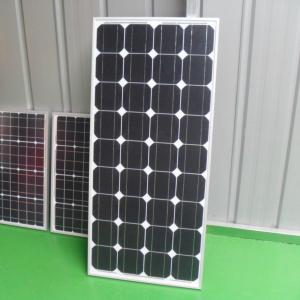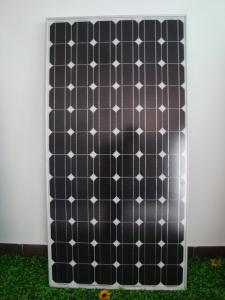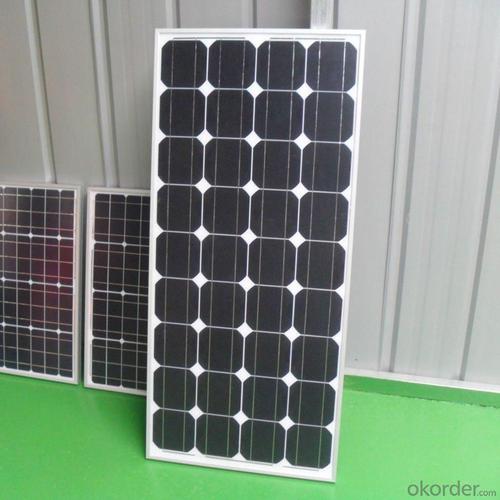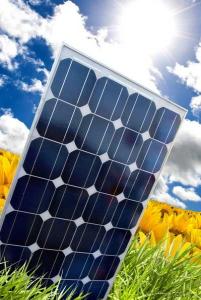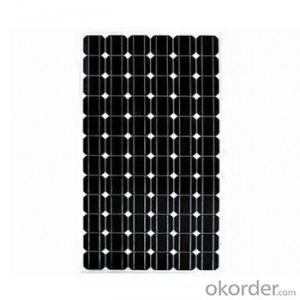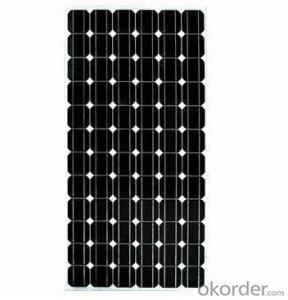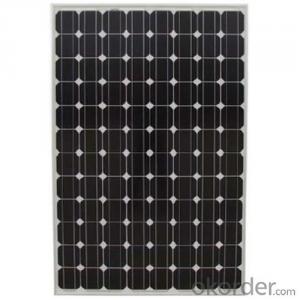Solar Panels for Sheds Kits - Solar Monocrystalline (210W-225W)
- Loading Port:
- Shanghai
- Payment Terms:
- TT
- Min Order Qty:
- 1 pcs pc
- Supply Capability:
- 100000/month pc/month
OKorder Service Pledge
OKorder Financial Service
You Might Also Like
Solar Monocrystalline (210W-225W)
Introduction of Solar Monocrystalline (210W-225W)
Solar modules use light energy (photons) from the sun to generate electricity through the photovoltaic effect. The majority of modules use wafer-based crystalline silicon cells or thin-film cells based on cadmium telluride or silicon. The structural (load carrying) member of a module can either be the top layer or the back layer. Cells must also be protected from mechanical damage and moisture. Most solar modules are rigid, but semi-flexible ones are available, based on thin-film cells. These early solar modules were first used in space in 1958.
CNBM Solar photovoltaic (PV) Panel is designed for large electrical power requirements. It is the optimal choice for both on-grid and off-grid power systems. CNBM Solar panel offers high performance of power per square foot of solar array. Monocrystalline silicon(c-Si): often made using the Czochralski process. Single-crystal wafer cells tend to be expensive, and because they are cut from cylindrical ingots, do not completely cover a square solar cell module without a substantial waste of refined silicon. Hence most c-Si panels have uncovered gaps at the four corners of the cells.
Characteristics of Solar Monocrystalline (210W-225W)
I. Solar Cell : High efficiency crystalline solar cell. Even if under the weak light, the solar module can produce maximum power output.
II. Tempered glass (toughened glass): Anti-reflecting coating and high transmission rate glass increase the power output and mechanical strength of solar module.
III. EVA and TPT: Using high quality EVA and TPT to prevent destroying and water.
IV. AI frame: Without screw, corner connection. 6 holes on the frame can be installed easily.
V. Junction box: Multi function junction box with water proof.
VI. Long lifetime: ≥25 years; Less power decrease.
VII. Good performance of preventing from atrocious weather such as wind and hails.
VIII. Resisting moisture and etching effectively, not effected by geology.
IX. The certificate issued by international authority: UL, TUV, IEC, VDE, CE.
Standard Test Conditions of Solar Monocrystalline (210W-225W)
The opto-electrical specifications shown below are stabilized values being measured at Standard Test Conditions, Irradiance: 1000W/m2, Spectrum: AM1.5 at 25°C, The info below is subject to manufacturing tolerances. Where appropriate minutes of measurement are available and are used for the dimensioning of the installation.
Advantages of Solar Monocrystalline (210W-225W)
• CNBM Solar performance guarantees for 25 years
• 10 years guarantee for workmanship
• Timeliness of delivery
• Quality Products certified (TÜV, UL, CE, VDE, ISO)
CNBM International Corporation's products including Monocrystalline Solar Panel, Polycrystalline Solar Panel have received and enjoyed famous reputation in many countries and regions in the world .As a solar panel manufacturer in China, we strive to provide our customers with excellent service, superior products and unmatched value.
Technical Data of Solar Monocrystalline (210W-225W)
Max Power Voltage Vmp (V) | 27.6V | 27.9V | 28.2V |
Max Power Current Imp (A) | 7.6A | 7.7A | 7.8A |
Open Circuit Voltage Voc (V) | 33V | 33.3V | 33.7V |
Short Circuit Current Isc (A) | 8.48A | 8.61A | 8.71A |
Max Power Pm (W) | 210W | 215W | 220W |
Temperature Coefficient of Cells
NOCT | 47℃±2℃ |
Temperature Coefficients of Isc (%/℃) | 0.0492 |
Temperature Coefficients of Voc (%/℃) | -0.3374 |
Temperature Coefficients of Pmp (%/℃) | -0.4677 |
Mechanical Data of Solar Monocrystalline (210W-225W)
Dimension | 1482×992×40mm |
Weight | 17kg |
Tolerance | 0~+5W |
The dimension of the modules can be changed according to the demand of clients
Limits of Solar Monocrystalline (210W-225W)
Operating Temperature | –40 °C to +85°C |
Storage Temperature | –40 °C to +85°C |
Max System Voltage | 1000VDC(IEC)/600VDC(UL) |
Guarantee of Solar Monocrystalline (210W-225W)
Products Guarantee | 10 yrs free from defects in materials and workmanship |
Performance Guarantee | No less than 90% within 10yrs and no less than 80% within 20yrs |
Certificates | IEC, ISO, TUV, CE |
The Application of Solar Monocrystalline (210W-225W)

The Pakage of Solar Monocrystalline (210W-225W)

- Q: . The 2v battery will only be turning a small 2v motor that will be turning very slowly yet possibly or a long time. 2. -2 hours max per day it will be running3. I want it to be fully sufficient on solar power once the energy in the battery runs out. What specifications for my panel do you think I will need. However, i have limited space so the smaller the better as long as it can do the jobP.S: I don't know much about electricity and solar power so simple answers please :)
- batteries are rated with the help of the CCA, chilly cranking Amps the better the CCa the longer it is going to very last, don,t imagine you want a charge Controller as your consistently drawing juice from it, the picture voltaic panel will keep the bat at its height , then even as the solar is down , the pump will draw off the bat,
- Q: i want to go off grid with solar panels but i need to know how many vots and watts i need to power my house
- Very simple. Look at your bills from the past year and calculate how much power you used and see what you need to cover that usage. How are we supposed to know how much power you use? Maybe you live in a bdrm trailer or a 6000 sg ft house with 20 kids. Oh and remember a few things. There is more to ' going off the grid ' than just solar panels. When the panels work depends a lot on your climate. They kind of suck on cloudy days or if you live in the artic with 6 months of darkness.Also , you need an area for the (not so cheap) storage batteries. Learn to live by cooking with gas or wood as hydro is limited , so is heat. How do you plan on heating your home /water/ refrigerators and freezers? Off the grid means a lot of compromise. Even the amount of time you can spend on the computer asking these questions. You may be limited to no more than hr per day. Off the grid also includes removing any electronic influence. No cell phones , tv (cable/sat) internet. Grow your own food and live off the land. The amount of solar panels you would need to maintain even a current lifestyle as most of us know it would probably require at least /2 acre and the cost would take at least 5-25 yrs to recover. You really need to spend more time into looking at what the cost versus return is. Like I said before. Look at what you use and see what it takes to get that from your panels. You will be shocked. Currently the panels are very good. But they cannot produce what the average home needs per day every day, they are support systems. Much like a fire place. Now they are nice to have and are very efficient. 50 yrs ago you used to toss in 2-3' logs about 6 around into the only heat source in your home. A fireplace. And it sucked more cold air into the house than the heat it produced. History has a way of repeating itself. This stuff was out almost a decade ago, they just didn`t have batteries then
- Q: Hi.How efficienent are solar panels? I mean, suppose we install a kw panel.. Wil it produce 5kw in 5 hours of good sun light?Or like if its 80 percent efficient, wil it produce 4kw and so on.Also, do the chinese solar panels give the same results as compared with panels from other countries?I live in india, so we get plenty of sunlight during the day.Thanks
- The Sunforce 50048 60-Watt solar charging kit is designed as an “out of the box” solution to your solar power needs.The Sunforce 50048 60-Watt Solar Charging Kit gives you several more reasons to love the sun.It provides the power you need, while helping you save money and protect the environment. This kit is ideal for cabins, recreational vehicles, remote power, back-up power, and 2-volt battery charging. It comes with everything you need to start producing up to 60 Watts/4 Amps of clean, free power in all weather conditions.
- Q: How much energy can solar panels generate?
- The amount of energy that solar panels can generate depends on various factors such as the size and efficiency of the panels, the location and climate conditions, and the amount of sunlight available. In general, a typical solar panel can produce around 250 to 400 watts of power per hour under optimal conditions. However, the overall energy output can vary significantly, and larger solar installations can generate much higher amounts of electricity.
- Q: my solar panel is 5v 50 mA, and im making iphone USB charger so i need to connect + with 00 ohm resister and to data - and + so what resister will be okay..?
- Just connect the 5 volts out of the panel directly to the iphone via an USB connector. BUT, is the panel output always 5 volts, ±0.25 volts? Because that is the USB specification, and anything outside of those values could damage your iphone. And solar panels are known for their wide swings in voltage. Bottom line, resistor not needed, and you need to be positive you supply the correct voltage to the iphone. Best way to do that is to start with a solar panel that puts out at least 7 volts and use a LM7805 regulator. The only resistors needed are those to tie the data lines into a certain combination of resistance and voltage so that the iphone is fooled into thinking that a proper USB is connected. That would NOT involve a 00 ohm resistor. Search online for the proper values and connections. edit: are you repeating your same inane question with a different account? That is totally against the rules and could get you suspended.
- Q: Can solar panels be installed on a prison or correctional facility?
- Yes, solar panels can be installed on a prison or correctional facility. In fact, many correctional facilities have embraced solar energy as a way to reduce their carbon footprint and save on energy costs. Solar panels can be installed on rooftops, parking lots, or open areas within the facility, providing renewable and clean energy to power various operations within the prison. This not only helps in reducing greenhouse gas emissions but also allows prisons to become more self-sufficient and sustainable.
- Q: I want to buy a solar panel from my house and I want to know how much it costs, what I have to buy and everything I need to know
- It depends on at least 3 factors, according to my friend Richard, who is a solar panel installer and electrician. ) how well your house is insulated 2) how good you are at conserving energy 3) how many stories (levels) your house has. $5,000 to 30,000 for the whole array because you will surely need more than one panel. In January of 2009 the government will be providing rebates or tax credits for solar panel installation. Good luck!
- Q: what kind of rays are used in solar panels?
- Ultra Violet rays from the sun.
- Q: They absorb solar heat and transform it into electricity, so there should be less heat left to warm the planet. Shouldn't we at least plaster all the world's deserts with them?
- No, the top argument is that extra CO2 is inflicting the ambience to keep greater warmth from the sunlight. Having image voltaic panels might scale returned the quantity of CO2 interior the ambience we are putting in it real now via giving us an means source that doesn't emit CO2, and that's approximately it.
- Q: I am looking at building my own solar panels to at least help cut down the rising energy bill. I know its expensive. I already have the solar cells so no need to worry about listing that. But i am looking at wiring it directly into the house. Is there any parts that you could list for me, that would be great. thanks
- Most okorder / . If you had an array of 0 or more panels, it would usually be cheaper to get a single, large inverter. The usual path taken with homemade panels seems to be using them to charge a battery, then running things of the battery. And it's usually a fun thing to do, but not a way to save money. Just so you know.
Send your message to us
Solar Panels for Sheds Kits - Solar Monocrystalline (210W-225W)
- Loading Port:
- Shanghai
- Payment Terms:
- TT
- Min Order Qty:
- 1 pcs pc
- Supply Capability:
- 100000/month pc/month
OKorder Service Pledge
OKorder Financial Service
Similar products
Hot products
Hot Searches
Related keywords
